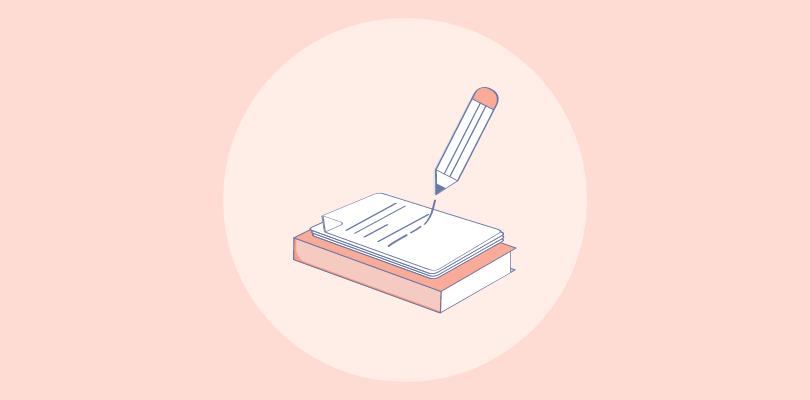Product documentation serves as the linchpin between complex product functionalities and customer satisfaction, ensuring that users can fully leverage the features they invest in.
Product documentation software enables this, minimizing user frustration and steep learning curves by providing a platform to create comprehensive documentation.
A report by the Content Marketing Institute found that 90% of top-performing B2B content marketers prioritize their readers’ informational needs over their sales/promotional message.
Being in the customer service and knowledge management industry for almost a decade, I understand the emphasis on delivering value with content, including detailed product documentation, can help businesses reduce support costs, enhance customer satisfaction, and increase retention rates.
In this blog, I will share the top 10 best product documentation tools and reveal their unique features and pricing details. Here’s a quick summary of my top three.
| Best Product Documentation Software | Best For | Pricing |
| ProProfs Knowledge Base | Easily creating product documentation, manuals, help sites, and private knowledge bases | Forever Free plan with all the premium features for up to 25 articles. Paid plan starts at $49/author/month |
| Scribe | Generating visual how-to guides | A free plan is available. Paid plan starts at $23/seat/month |
| RoboHelp | Multi-platform publishing | A 30-day free trial is available. Paid plan starts from $29.99/month |
Now, before jumping to the list, let’s discuss some basics.
What Is Product Documentation Software?
Product documentation software is a specialized tool designed to help organizations create, manage, and publish documentation accompanying their products. This tool helps ensure that users have easy access to necessary information, including user guides, manuals, installation instructions, and troubleshooting tips.
It helps to effectively communicate how a product works, how to resolve issues, and how to maximize its potential, enhancing the overall customer experience.
For example, technical writers and product managers of an electronics company can use a product documentation tool to create FAQ pages around product features, pricing, availability, usage, and more.
Users can access these help resources online 24/7, which significantly aids in on-the-spot assistance and reduces learning time. Online help systems created with such software can include text, images, videos, and hyperlinks to related topics, providing a rich, interactive user experience.
Which Is the Best Product Documentation Software in 2025?
Choosing robust product documentation software ensures that all product-related information is accurate, easy to access, and consistently updated.
When selecting such software, look for features like easy content management, integration capabilities with your current tech stack, robust search functionalities, and good user feedback mechanisms.
Option #1 – ProProfs Knowledge Base
ProProfs Knowledge Base, with its Word-like WYSIWYG editor and documentation templates, helps create user manuals and FAQs efficiently (public, private, or embedded inside your app/software or integrated with chat). Its collaborative features, like internal comments, smart user management, custom workflows, and more, make document collaboration easy.
Option #2 – Scribe
Scribe specializes in automating the process of creating step-by-step guides, making it an excellent tool for developing clear and concise product documentation. It automatically captures your workflows as you perform them, producing visual guides that include screenshots and instructional text.
Option #3 – RoboHelp
Adobe RoboHelp supports responsive HTML5 content, ensuring online documentation is accessible on any device. It also provides dynamic filters to enhance user experience. Its content personalization capabilities allow businesses to tailor documentation to meet the specific needs of different audience segments.
Top 10 Best Product Documentation Software & Tools in 2025
Product documentation software helps reduce customer support calls by providing users with self-service resources. Empowering users to solve problems independently not only improves customer satisfaction but also decreases the company’s overall support cost.
Without any further do, let’s explore my top 10 product documentation tools.
1. ProProfs Knowledge Base – Best for Easily Creating Product Documentation, Help Sites, Manuals & Private Knowledge Bases
Our team frequently uses ProProfs Knowledge Base’s AI-powered WYSIWYG editor, which enables us to see what we get while creating product documentation, manuals, and internal knowledge bases without technical expertise. It enables us to easily format text, insert images, videos, links, and layout content with minimal effort.
It supports real-time co-authoring and version control, making it easy for teams to collaborate on documents without the risk of overwriting each other’s work. Managers can also set user roles and permissions to control who can edit or view specific content.
The platform also enables robust customization options that allow businesses to align their documentation with their brand identity. Brands can customize the look and feel of their knowledge base with templates, logos, and color schemes that match their corporate branding.
What you will like:
- Variety of knowledge base templates to help you get started quickly
- Ability to create multiple copies of a single help site and brand them differently
- Ability to group articles together in a single widget, which your customers can access instantly
- Allows you to create different help site versions easily – lets you switch between different versions as and when required
- Lets you easily perform actions like publishing, hiding, showing, deleting, and moving multiple articles with just a few clicks
What you may not like:
- The freemium plan is only limited to 25 articles
- Lacks an on-premise version
Pricing:
Forever Free plan with all the premium features for up to 25 articles. Paid plan starts at $49/author/month.
2. Scribe – Best for Generating Visual How-To Guides
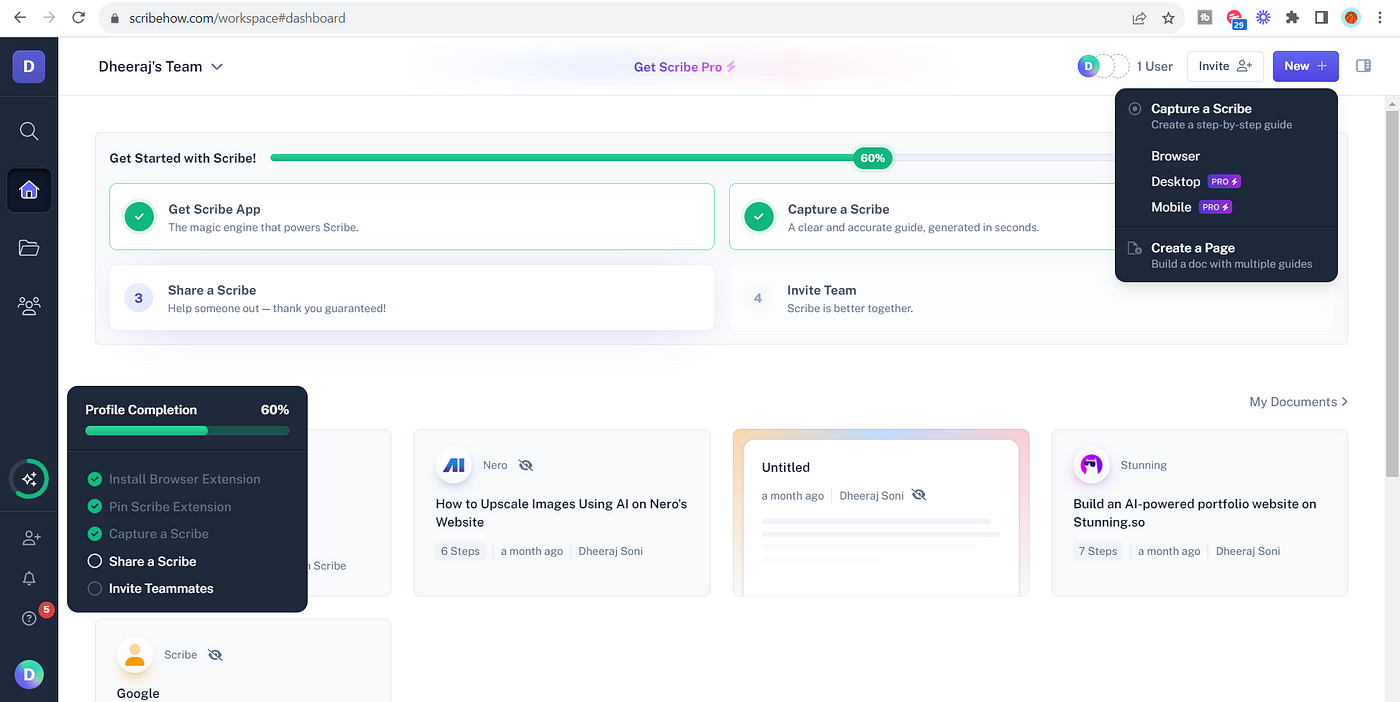
I like how Scribe enables teams to capture and document processes automatically as they work and records each step of a task as it is performed, including taking screenshots, which it then compiles into a clear, step-by-step guide. This is especially useful for creating tutorial content and training materials that require accuracy and detail.
You can then enhance these guides with annotations and text explanations, which can be edited and formatted to add additional context or instructions. This helps creators to customize their documentation to ensure that all nuances and important details are clearly communicated.
What you will like:
- The built-in documentation editor makes editing and formatting documentation easy
- The customizable templates help you align documentation with company branding
- Seamless integration with popular tools like Zendesk and Confluence for efficient documentation management.
What you may not like:
- I would love to see the ability to capture video and incorporate that into Scribe documents
- There should be an option to pause the recording process sometimes so it doesn’t pick up on extra steps that take time to remove.
Pricing:
A free plan is available. Paid plan starts at $23/seat/month.
3. RoboHelp – Best for Multi-Platform Publishing
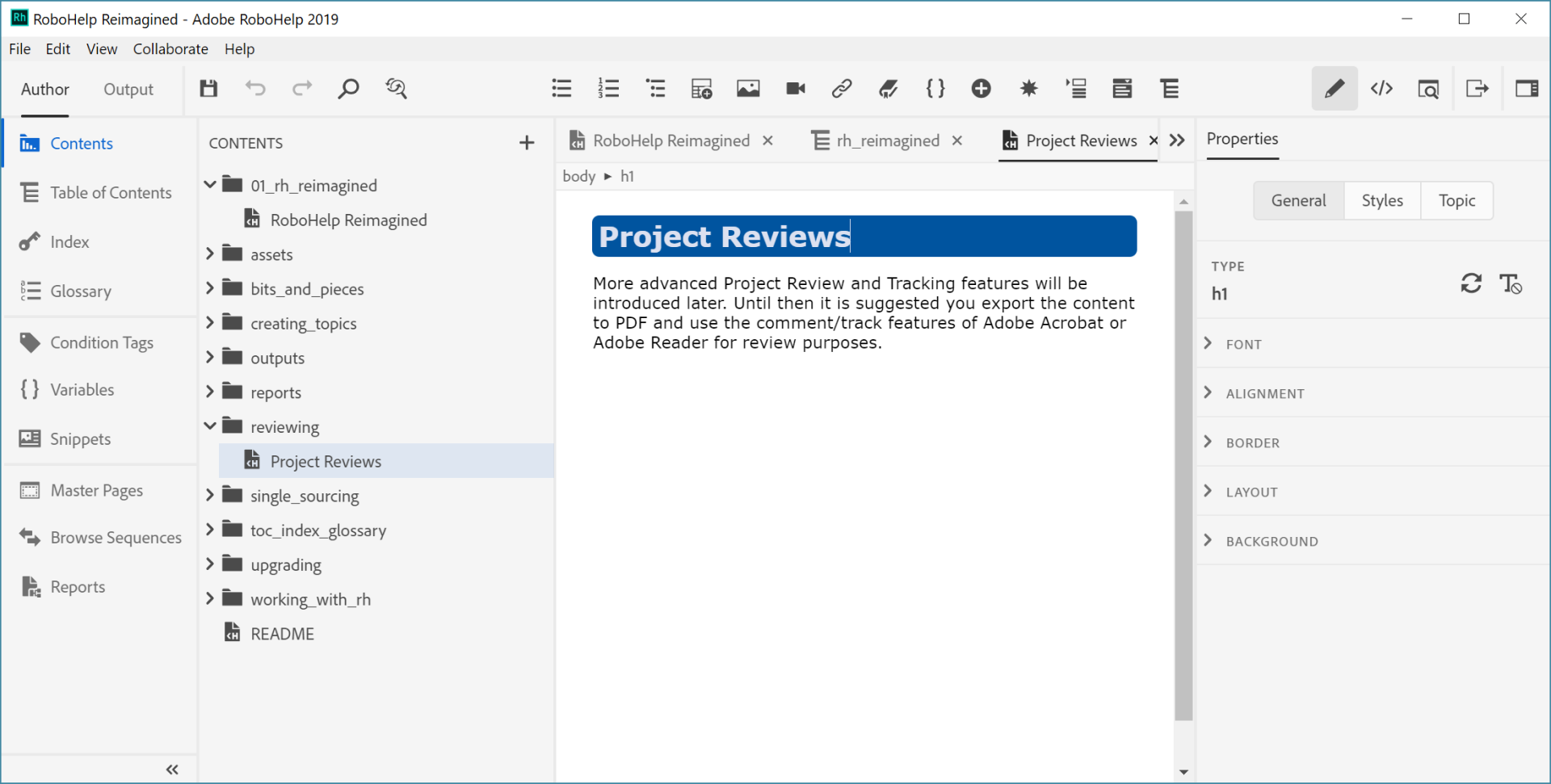
RoboHelp supports HTML5 and allows users to generate responsive documentation that adapts seamlessly to any device, be it a desktop, tablet, or smartphone. I love its responsiveness, which ensures end-users have a consistent experience across all platforms, enhancing user engagement and satisfaction.
It also offers a rich set of templates and predefined styles that help streamline the documentation process, making it easier for writers to maintain consistency in the look and feel of their documents. Dynamic content filtering augments its powerful authoring and publishing capabilities.
What you will like:
- Enables you to create personalized experiences for different audiences by applying conditional content that displays only relevant information based on the user’s role, location, or preference
- Tight integration with leading content management systems and can import content from various sources, including Microsoft Word, Excel, and HTML pages
- The ability to produce help systems that can be integrated directly into software applications or web platforms
What you may not like:
- I found the learning curve for the tool a bit steep
- RoboHelp requires some basic HTML knowledge to get the most out of the experience
Pricing:
A 30-day free trial is available. Paid plan starts from $29.99/month.
4. GitHub – Best for Creating Documentation Via Repositories

GitHub allows teams to manage their documentation alongside their code, making it an integral part of the development process. This integration ensures that documentation keeps pace with software changes, providing developers and end-users with up-to-date and relevant information.
The platform’s support for Markdown files allows for the creation of formatted text using a plain text editor, making it simple for contributors to write documentation without needing to learn complex web languages. This ease of use encourages more developers to participate in the documentation process, ensuring that the documentation is comprehensive and reflects diverse perspectives.
What you will like:
- Supports extensive collaboration features like branches and pull requests
- Powerful version control capabilities ensure that every change to the documentation is tracked and previous versions are readily accessible
- GitHub Pages allows users to host documentation directly from a GitHub repository on the web
What you may not like:
- Primarily being a code repository, its documentation features like Wikis are basic compared to dedicated tools
- Some users report the need for more customization options for advanced formatting
Pricing:
A free plan is available. Paid plan starts at $3.67/user/month.
5. ClickHelp – Best for Creating & Publishing Context Help-Sensitive Documentation
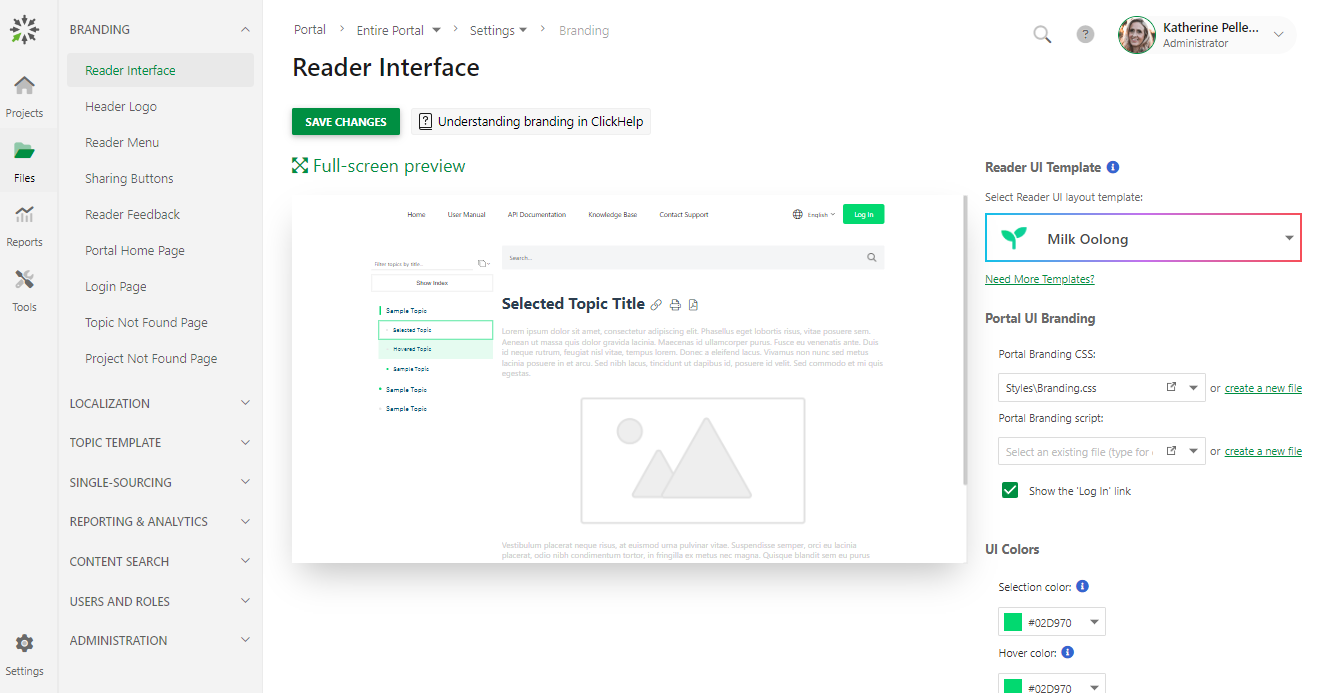
ClickHelp enables my favorite implementation of context-sensitive help documentation, which is crucial for providing relevant information to users based on their current tasks or navigation within software applications. It allows technical writers to design help content that is dynamically linked to specific interface elements in software applications.
The platform lets users access help articles directly from the application interface they are interacting with without needing to search through a help portal. This integration is achieved through context identifiers or help IDs that developers assign within the application code, which ClickHelp uses to serve the right content to users at the right time.
What you will like:
- Supports full-text search capabilities powered by advanced algorithms to deliver search results quickly and accurately
- Supports multiple output formats such as HTML5, PDF, and CHM, ensuring that documentation is accessible on a variety of devices and platforms
- The ability to insert multimedia elements like images, videos, and diagrams
What you may not like:
- The Wiki and documentation features may be less intuitive for non-developers
- I felt that the interface could be cluttered and not as intuitive for new users
Pricing:
Paid plan starts at $175/2 contributors/month.
6. Doxygen – Best for Automating Code Documentation
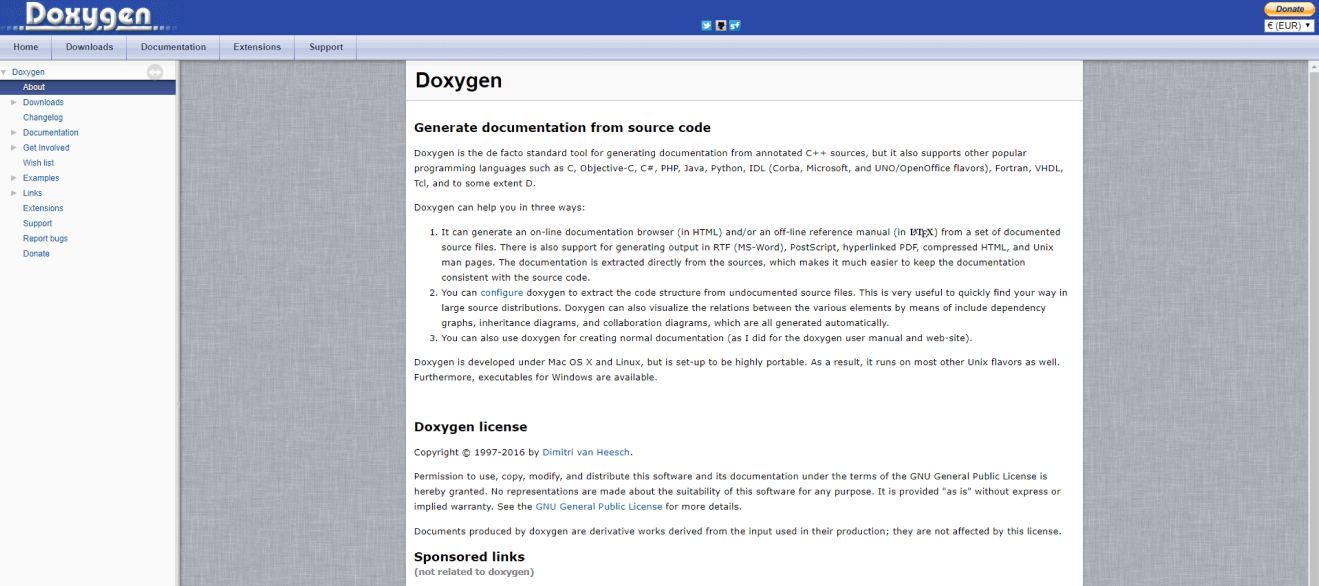
I like Doxygen for its ability to automate the creation of technical documentation directly from the codebase. It supports multiple programming languages, including C++, C, Java, Objective-C, Python, and others, making it versatile for diverse development environments.
Its ability to automate code documentation works by extracting documentation from source code comments, which are formatted according to Doxygen’s configurable markup. Developers can write annotations directly in the code, and Doxygen parses these annotations to generate comprehensive and structured documentation in various output formats, such as HTML, LaTeX, RTF, and PDF.
What you will like:
- The ability to generate visual representations of relationships within the code through graphs
- Integrates with tools like Graphviz to create class diagrams, inheritance diagrams, collaboration diagrams, and call graphs
- The ability to visually map out components is invaluable for larger projects with complex architectures, enhancing readability and comprehension
What you may not like:
- Needs a good understanding of the specific markup for optimal use
- The lack of real-time collaboration features
Pricing:
Doxygen is a free, open-source platform.
7. Nuclino – Best for Fast Collaboration to Bring Knowledge, Docs & Projects Together in One Place
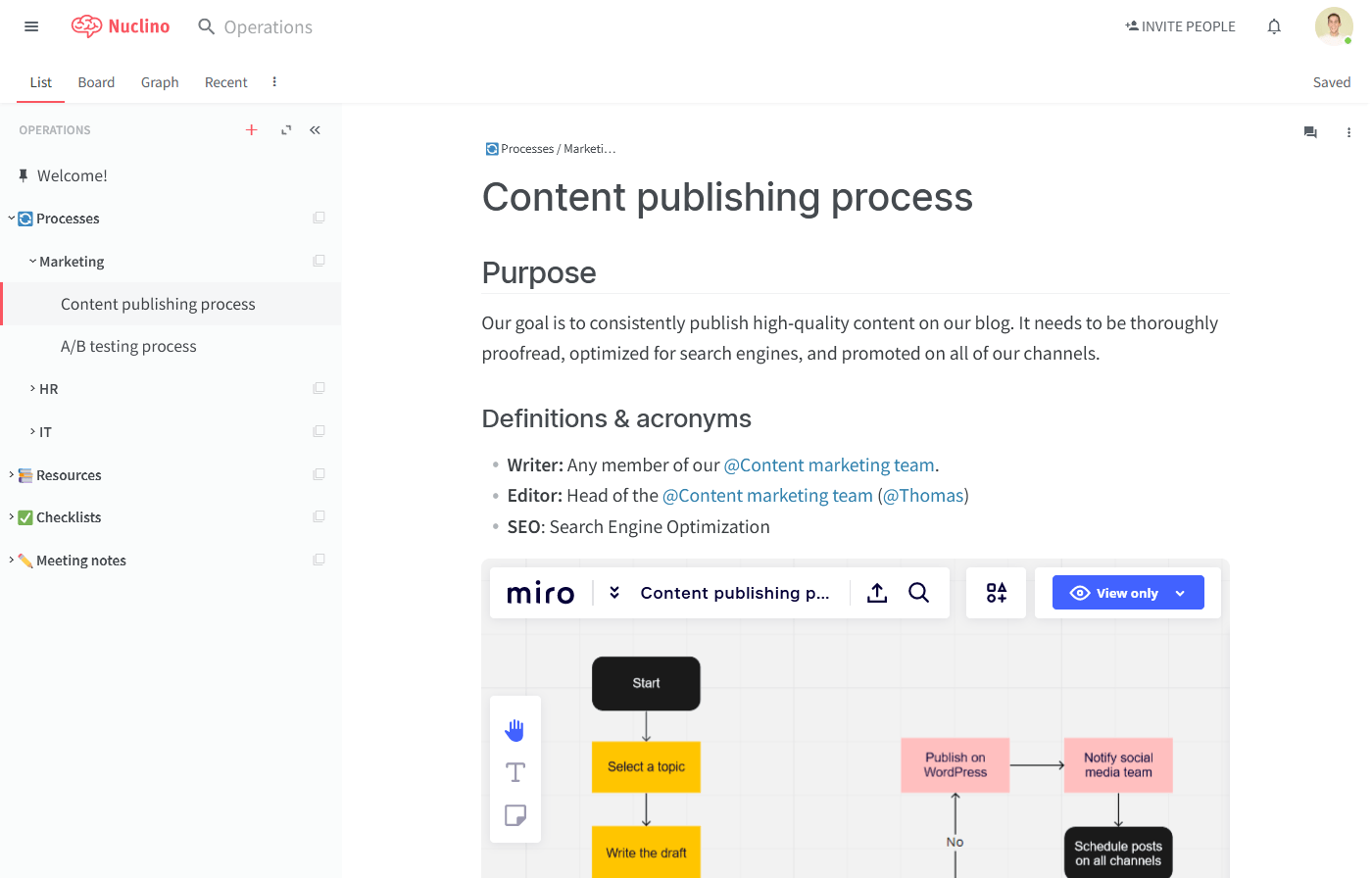
I chose Nuclino for its unified workspace where team members can contribute to documents simultaneously, much like Google Docs. This real-time collaboration feature ensures that all contributors can see the latest updates as they are made, discuss modifications, and iterate quickly.
Documents within Nuclino can be linked like a wiki, allowing users to create a network of interlinked pages. This setup is handy for creating comprehensive product documentation that often requires cross-referencing related topics. Users can navigate through this network using intuitive search and tagging features, which makes finding specific information effortless and quick.
What you will like:
- Supports embedding content from various external sources such as YouTube, Google Maps, and more
- Offers powerful visualization tools, like its graphical view, which maps out all the documents in a workspace as an interactive graph
- Handy mind-map-like diagram of files and folders
What you may not like:
- I have noticed that the search does not handle typos. It will show zero results if you mistype
- Lack of function to export a whole project/board into a PDF folder
Pricing:
A free plan is available for up to 50 items. Paid plan starts at $5/user/month.
8. Confluence – Best for Team Collaboration on Documents
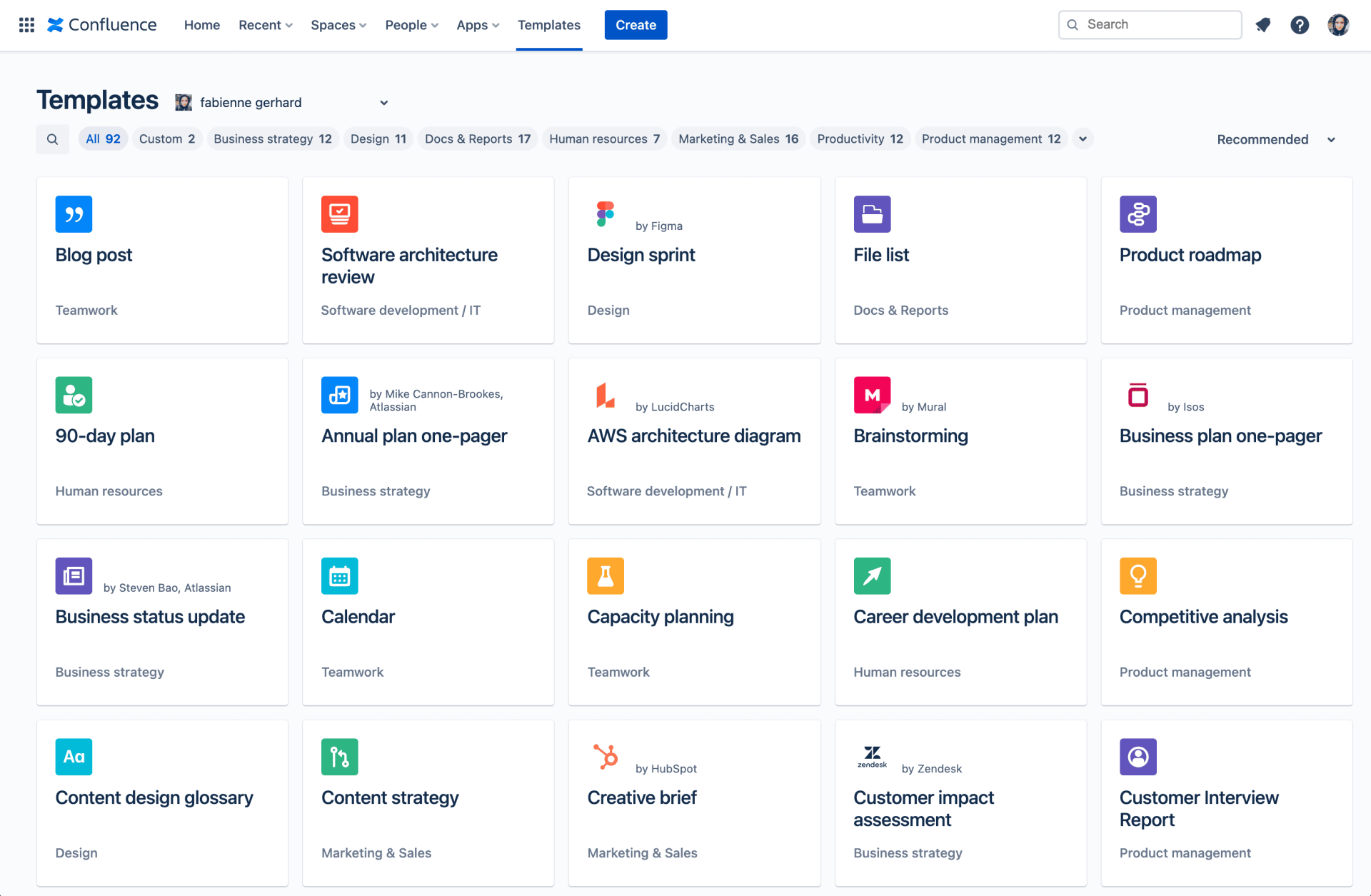
Designed as a versatile workspace, Confluence integrates seamlessly with other Atlassian products and supports various documentation needs, from technical manuals to project deliverables and everything in between. It enables teams to work together on documents in real-time, making simultaneous edits and providing instant feedback through inline comments and discussions.
The platform also allows users to create spaces dedicated to specific projects or teams, within which pages and sub-pages can be organized hierarchically. This structure is supported by powerful search capabilities that help users quickly locate the necessary information.
What you will like:
- Intuitive navigation and tagging system
- Offers hundreds of plugins and add-ons, ranging from content formatting and diagrams to security and workflow management
- Lets users embed videos, insert files, and use macros to pull in live data or automate content creation
What you may not like:
- New users may find it overwhelming for new users due to its extensive features
- While it integrates well with other Atlassian products, integration with non-Atlassian products can be less seamless
Pricing:
A free plan is available. Paid plan starts at $60.05/10 users/month.
9. Bit.ai – Best for Rich Multimedia Support in Documentation
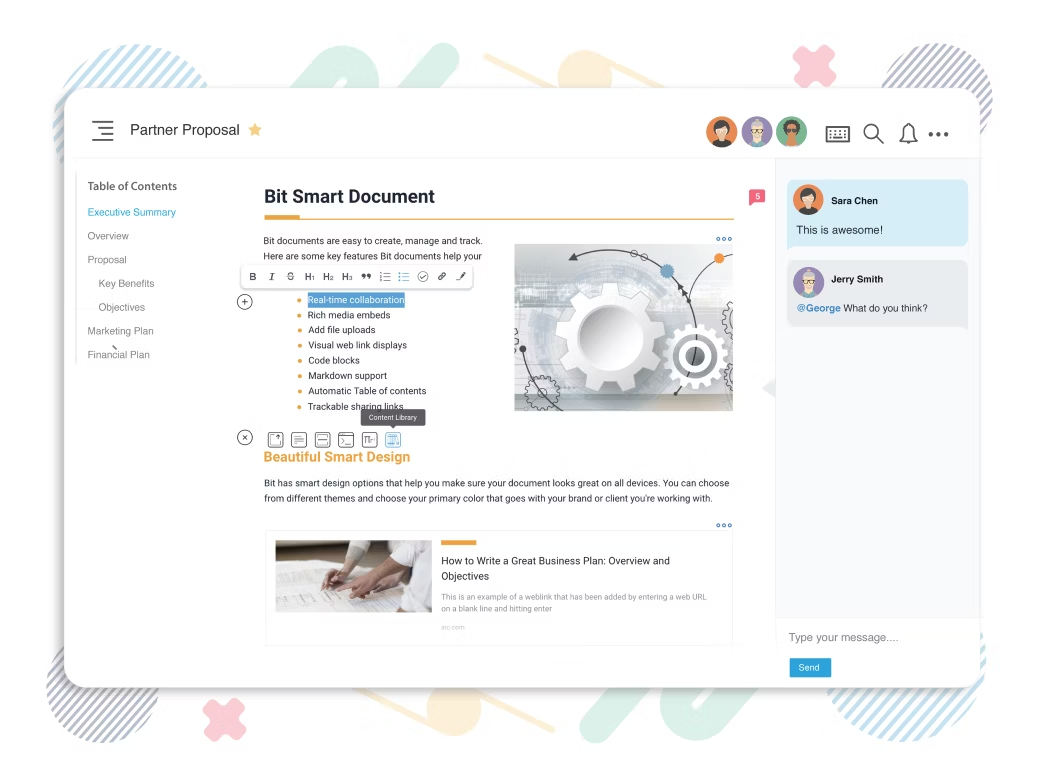
Bit.ai enables users to enrich their documents with various media types, transforming traditional documentation into engaging and interactive experiences. Its robust multimedia support allows users to directly incorporate videos, GIFs, images, and other rich media into their documents.
My favorite is its smart workspaces, which are collaborative environments where documents and related content can be easily accessed and shared with team members. Each workspace can be customized with different access levels, ensuring that sensitive information remains secure while promoting teamwork and transparency.
What you will like:
- Enables real-time co-editing and comments, making it easy for teams to work together from any location
- Integrates seamlessly with various popular tools and platforms, like Slack, Google Drive, and Microsoft Office
- Smart search feature to find content quickly
What you may not like:
- Some users have reported slow loading times and lag with heavily multimedia-enriched documents
- Some users may find the organization of documents in workspaces confusing
Pricing:
It offers a free plan. Paid plan starts at $8/member/month.
10. Document360 – Best for Creating Online Documentation
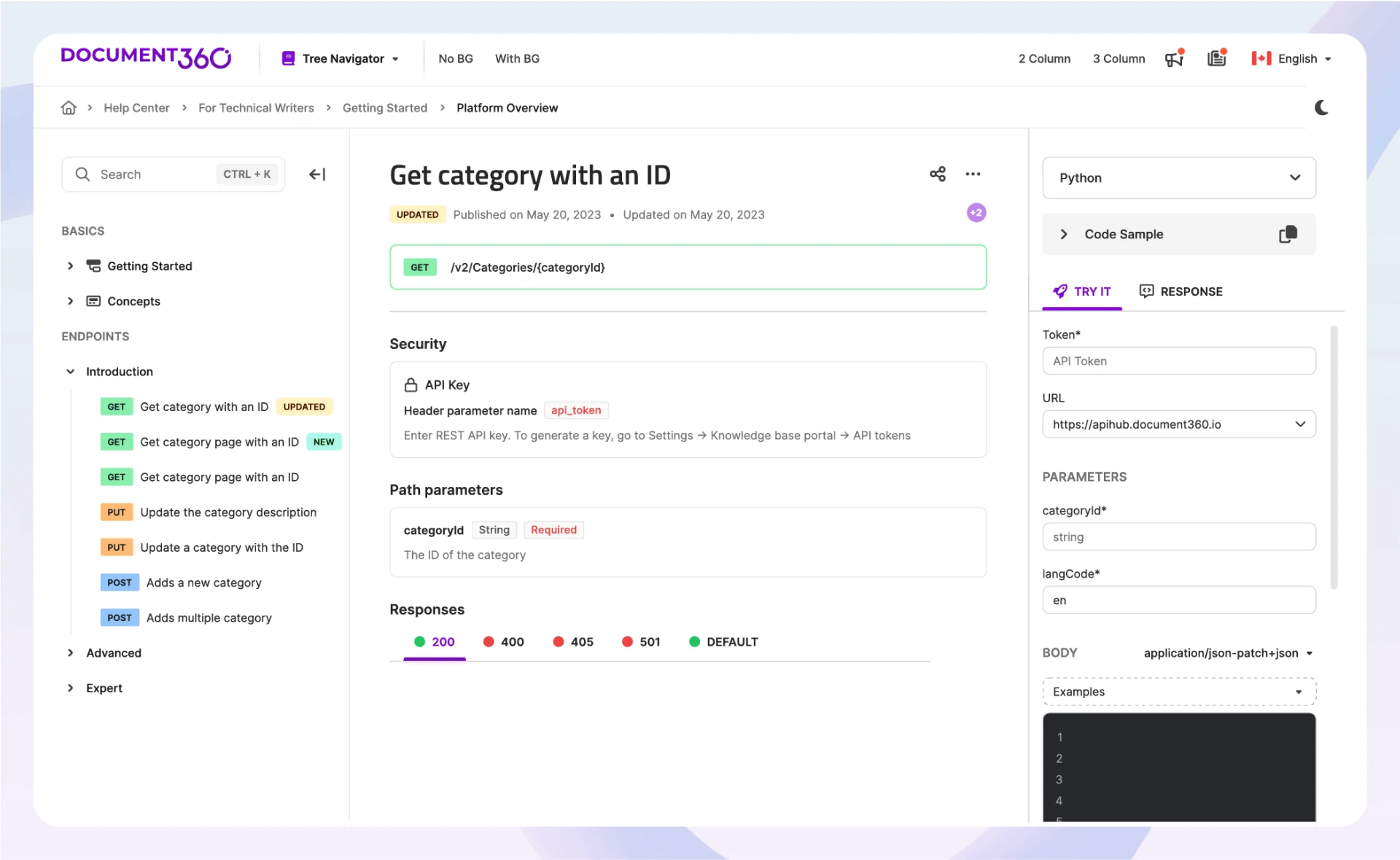
I explored Document360 at my previous company. It is a robust knowledge base portal that allowed us to create a self-service hub for customers or internal staff. We could easily create, categorize, and manage articles using an intuitive editor that supports Markdown and WYSIWYG interfaces.
The platform also enables version control, where each revision is tracked meticulously, allowing teams to revert to previous versions if necessary. It can branch out content, enabling simultaneous updates of different versions of the documentation without conflicts.
What you will like:
- Powerful search engine which uses machine learning to provide fast and accurate search results
- Supports multiple integrations with third-party tools such as Slack, Microsoft Teams, and various analytics platforms
- Supports multiple languages, making it an excellent choice for global companies
What you may not like:
- Its initial setup and organization can be time-consuming
- New users may find the interface and certain features overwhelming without sufficient onboarding
Pricing:
A free plan is available. Paid plan starts at $149/project/month.
Evaluation & Selection Criteria
The evaluation of products or tools chosen for this article follows an unbiased, systematic approach that ensures a fair, insightful, and well-rounded review. This method employs six key factors:
- User Reviews/Ratings: Direct user experiences, including ratings and feedback from reputable sites, provide a ground-level perspective. This feedback is critical in understanding overall satisfaction and potential problems.
- Essential Features & Functionality: The value of a product is ascertained by its core features and overall functionality. Through an in-depth exploration of these aspects, the practical usefulness and effectiveness of the tools are carefully evaluated.
- Ease of Use: The user-friendliness of a product or service is assessed, focusing on the design, interface, and navigation. This ensures a positive experience for users of all levels of expertise.
- Customer Support: The quality of customer support is examined, considering its efficiency and how well it supports users in different phases – setting up, addressing concerns, and resolving operational issues.
- Value for Money: Value for money is evaluated by comparing quality, performance, and features. The goal is to help the reader understand whether they are getting their money’s worth.
- Personal Experience/Expert’s Opinion or Favorites: This part of the evaluation criteria draws insightful observations from the writer’s personal experience and the opinions of industry experts.
Considering all the above factors, ProProfs Knowledge Base emerges as the perfect solution with its AI-powered WYSIWYG editor and rich documentation templates.
FREE. All Features. FOREVER!
Try our Forever FREE account with all premium features!
Improve Operational Efficiency With Comprehensive Product Documentation
Product documentation helps enhance customer support, simplify complex information, and boost user engagement cannot be overstated. The tools in this list provide various features that can suit different organizational needs, from startups to large enterprises, aiming to optimize documentation processes.
ProProfs Knowledge Base is a comprehensive solution combining ease of use and powerful functionality. With features like an AI text editor, real-time collaboration, and robust analytics, ProProfs Knowledge Base ensures that your documentation is not only easy to create but also effective in serving its purpose.
Explore what ProProfs Knowledge Base can offer and how it can transform your documentation efforts.
 Tips
Tips
We’d love to hear your tips & suggestions on this article!
FREE. All Features. FOREVER!
Try our Forever FREE account with all premium features!

 We'd love your feedback!
We'd love your feedback! Thanks for your feedback!
Thanks for your feedback!


